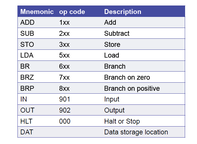Overall Learning Intention:
"To understated the role of the various parts of the Von Neumann CPU architecture and how they function together to Fetch, Decode and Execute instructions for a number of mathematical formulae."
Lesson 1: Introduction to LMC
Learning Intention: This lesson introduces you computer instructions that are run at the processor level. You will learn how a processor uses instructions to performs calculations. You will also discover that adding two numbers together is not as simple as you thought.
Lesson 2: Problem Solving with LMC
Learning Intention: This second lesson focuses on further developing your LMC skills. You will have to solve a number of LMC based problems. The key is that you plan, plan, plan and try, try and try and then some, to create a solution. Use as many ways as you can to try and find a solution.
Lesson 3: Looping with LMC
Starter: Describe either the MAR, MDR, PC or ACC and get another student to try and guess what you are describing. Do not use the main words or a verb version.
Try out the looping program below.
Learning Intention: You will learn how to create a simple loop in LMC. You will then alter the program to enable the program to loop a set number of times (iterations). Design the code first using a Flow Diagram or Pseudo code.
Lesson 4: Multiplying with LMC
Learning Intention: In this session you will be able to use Loops (iteration) from the previous lesson to create an LMC program which multiples two numbers together.
Learning Intention: In this session you will be able to use Loops (iteration) from the previous lesson to create an LMC program which multiples two numbers together.
- Create a flow chart which shows each stage of the LMC program that would multiply two numbers together.
- Use your Flow chart and LMC to create a program which multiplies two numbers together. Use a count to keep track of when the number 'runs out'.

